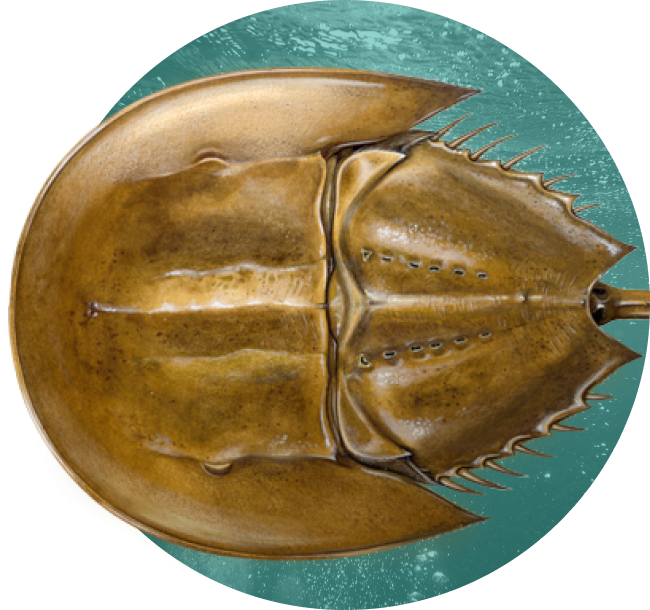Long Branch, NJ – The Commission’s Horseshoe Crab Management Board approved harvest specifications for horseshoe crabs of Delaware Bay-origin. Taking into consideration the recommendations of the Adaptative Resource Management (ARM) Framework Revision, the Board set a harvest limit of 475,000 male horseshoe crabs and zero female Delaware Bay-origin horseshoe crabs for the 2023 season.
“The ARM Framework Revision represents a considerable advancement in the science upon which we manage horseshoe crabs in the Delaware Bay Region,” stated Board Chair John Clark of Delaware. “ASMFC is very proud of this effort and the improvements that have been made to the model and data inputs for both horseshoe crabs and red knots. The Board’s action today is consistent with the goal of balancing ecosystem and fishery needs.”
Acknowledging public concern about the status of the red knot population in the Delaware Bay, the Board elected to implement a zero female horseshoe crab harvest for the 2023 season as a conservative measure. To make up for the lost harvest of larger female crabs, the Board agreed to increase Maryland and Virginia’s male harvest quotas with an offset ratio of 2:1 males to females. Using the allocation methodology established in Addendum VIII, the following quotas were set for New Jersey, Delaware, Maryland, and Virginia:
The Board also approved Addendum VIII to the Interstate Fishery Management Plan (FMP) for Horseshoe Crab. Addendum VIII adopts the changes to the ARM Framework as recommended in the peer-reviewed 2021 ARM Framework Revision, and allows its use in setting annual bait harvest specifications for horseshoe crabs of Delaware Bay-origin. The Board initiated Draft Addendum VIII in January 2022, after accepting the 2021 Revision of the ARM Framework and Peer Review Report for management use. The 2021 Revision includes improvements to the ARM Framework’s population models for horseshoe crabs and red knots and incorporates more sources of horseshoe crab removal data, including mortality due to the biomedical industry and commercial discards from other fisheries. Given these improvements, which address previous peer review critiques, the ARM Revision was endorsed by the independent peer review panel as the best scientific information for the management of horseshoe crabs in the Delaware Bay Region that accounts for the forage needs of migratory shorebirds.
Since 2013, horseshoe crabs in the Delaware Bay Region (New Jersey, Delaware, Maryland, and Virginia) have been managed under the ARM Framework to set harvest levels with consideration of the needs of migratory shorebirds. The ARM was developed jointly by the Commission, U.S. Fish and Wildlife Service, and U.S. Geological Survey in recognition of the importance of horseshoe crab eggs to migratory shorebirds stopping over in the Delaware Bay region. In particular, horseshoe crab eggs are an important food source for the rufa red knot, which is listed as threatened under the Endangered Species Act.
Under Addendum VIII, the 2021 ARM Revision will be used to annually produce bait harvest recommendations for male and female horseshoe crabs of Delaware Bay-origin, based on the abundance of horseshoe crabs and red knots. The maximum number of male and female horseshoe crabs the ARM Revision can recommend (500,000 males and 210,000 females) and the conceptual model of horseshoe crab abundance influencing red knot survival and reproduction remain unchanged, with the objective of ensuring horseshoe crab abundance does not become a limiting factor for the population growth of red knots. While the methodology for allocating the overall quota among the four Delaware Bay states is also unchanged, the state allocations have been updated to reflect the most current genetic information on the proportion of each state’s harvest that is of Delaware Bay-origin.
The Addendum will be available next week on the Commission website, www.asmfc.org, under Management Plans & FMP Reviews. A more detailed overview of the 2021 ARM Revision can be found here. The final ARM Revision and Peer Review Report is available here. The U.S. Geological Survey released the software code for the ARM Framework models on November 3, which is posted on GitLab at https://code.usgs.gov/cooperativeresearchunits/hsc-adp/-/releases. A description of the software release can be found in a Readme summary at https://code.usgs.gov/cooperativeresearchunits/hsc-adp/-/tree/main.
For more information, please contact Caitlin Starks, Senior Fishery Management Coordinator, at cstarks@asmfc.org or 703.842.0740.
